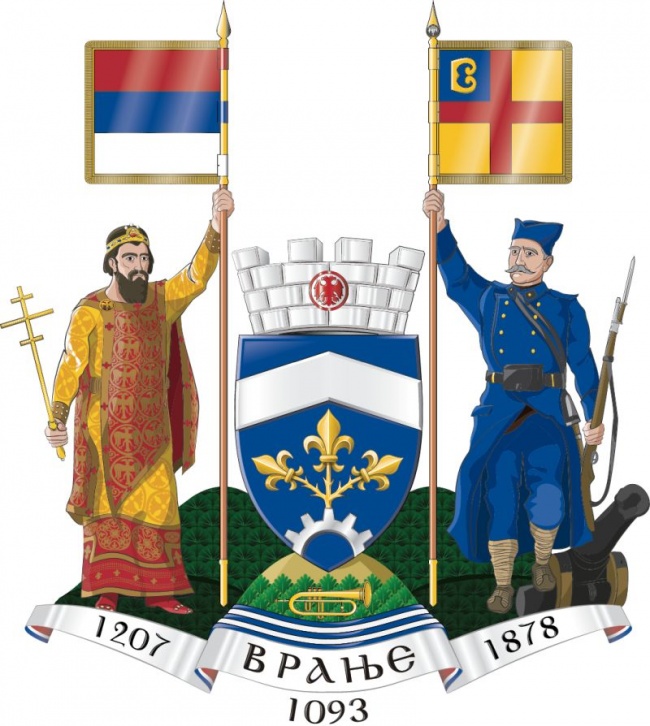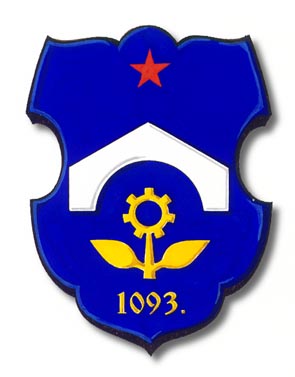Vranje: Difference between revisions
Knorrepoes (talk | contribs) m (Text replace - "[[Literature" to "{{media}} [[Literature") |
Knorrepoes (talk | contribs) m (Text replacement - "Literature :" to "'''Literature'''") |
||
| (8 intermediate revisions by the same user not shown) | |||
| Line 1: | Line 1: | ||
{ | {{rs}} | ||
'''VRANJE (Врање)''' | '''VRANJE (Врање)''' | ||
| Line 9: | Line 5: | ||
District : Pčinja | District : Pčinja | ||
[[File:vranje2.jpg|center]] | [[File:vranje2.jpg|center|650 px|Coat of arms (crest) of {{PAGENAME}}]] | ||
====Origin/meaning | ===Official blazon=== | ||
===Origin/meaning=== | |||
The arms show a blue shield as one of the national colors of Serbia which represents loyalty. Blue or Old Slavic "morav" is also an allusion to the South Morava river as the most important river of Vranje region. | |||
The broken chevron in the chief symbolizes the White Bridge as the best known landmark of the city. The cogwheel in the base represents the industry of Vranje, which was most responsible for the development of the city after World War II, when it becomes the center of the development of South Serbia and that part of Yugoslavia. For this reason three golden lily-stems grow from the wheel, a symbol of wealth. | |||
The lilies are also a symbol of resistance and the suffering of the people of Vranje during the two occupations of the city, one Ottoman and two Bulgarian, and the rebirth of the city after this occupations. | |||
on the right heraldic side king Stefan the First and on the left a soldier from the Serbo-Turkish wars in full winter artillery uniform. | |||
The whole composition stands on a scroll, on which is inscribed the name of a city between the dates 1207 (the year of entry to the Serbian medieval state) and 1878 (the year of entry of Vranje in the modern Serbian state). The reverse of the scroll shows the tricolor of the Principality of Serbia. | |||
Below the scroll is the year 1093 the year in which Vranje is first mentioned in the "Alexiad" of Anna Komnene, Byzantine princess and historian. | |||
The previous arms: | The previous arms: | ||
| Line 19: | Line 27: | ||
{{media}} | {{media}} | ||
[[Literature]] | [[Civic Heraldry Literature - Serbia|'''Literature''']] Image and info by Nemanja Todorović Štiplija | ||
[[Category:Serbia]] | [[Category:Serbia]] | ||
[[Category:Pčinja]] | [[Category:Pčinja]] | ||
Latest revision as of 09:12, 1 September 2023
| Heraldry of the World |
| Serbian heraldry portal Хералдика Србије |
|
VRANJE (Врање)
District : Pčinja
Official blazon
Origin/meaning
The arms show a blue shield as one of the national colors of Serbia which represents loyalty. Blue or Old Slavic "morav" is also an allusion to the South Morava river as the most important river of Vranje region.
The broken chevron in the chief symbolizes the White Bridge as the best known landmark of the city. The cogwheel in the base represents the industry of Vranje, which was most responsible for the development of the city after World War II, when it becomes the center of the development of South Serbia and that part of Yugoslavia. For this reason three golden lily-stems grow from the wheel, a symbol of wealth.
The lilies are also a symbol of resistance and the suffering of the people of Vranje during the two occupations of the city, one Ottoman and two Bulgarian, and the rebirth of the city after this occupations.
on the right heraldic side king Stefan the First and on the left a soldier from the Serbo-Turkish wars in full winter artillery uniform.
The whole composition stands on a scroll, on which is inscribed the name of a city between the dates 1207 (the year of entry to the Serbian medieval state) and 1878 (the year of entry of Vranje in the modern Serbian state). The reverse of the scroll shows the tricolor of the Principality of Serbia.
Below the scroll is the year 1093 the year in which Vranje is first mentioned in the "Alexiad" of Anna Komnene, Byzantine princess and historian.
The previous arms:
Contact and Support
Partners:
Your logo here ?
Contact us
© since 1995, Heraldry of the World, Ralf Hartemink 
Index of the site
Literature Image and info by Nemanja Todorović Štiplija














